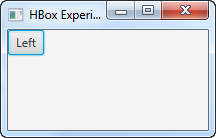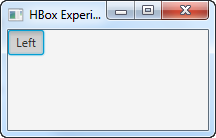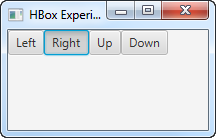JavaFX ToggleButton
Jakob Jenkov |
A JavaFX ToggleButton is a button that can be selected or not selected. Like a button that stays in when you
press it, and when you press it the next time it comes out again. Toggled - not toggled. The JavaFX ToggleButton
is represented by the class javafx.scene.control.ToggleButton .
Creating a ToggleButton
You create a JavaFX ToggleButton by creating an instance of the ToggleButton class. Here is
an example of creating a JavaFX ToggleButton instance:
ToggleButton toggleButton1 = new ToggleButton("Left");
This example creates a ToggleButton with the text Left on.
Adding a ToggleButton to the Scene Graph
To make a ToggleButton visible you must add it to the JavaFX scene graph. This means adding it to
a Scene, or as child of a layout which is attached to a Scene object.
Here is an example that attaches a JavaFX ToggleButton to the scene graph:
package com.jenkov.javafx.controls;
import javafx.application.Application;
import javafx.scene.Scene;
import javafx.scene.control.ToggleButton;
import javafx.scene.layout.HBox;
import javafx.stage.Stage;
public class ToggleButtonExperiments extends Application {
@Override
public void start(Stage primaryStage) throws Exception {
primaryStage.setTitle("HBox Experiment 1");
ToggleButton toggleButton1 = new ToggleButton("Left");
HBox hbox = new HBox(toggleButton1);
Scene scene = new Scene(hbox, 200, 100);
primaryStage.setScene(scene);
primaryStage.show();
}
public static void main(String[] args) {
Application.launch(args);
}
}
The application resulting from running the above example code is illustrated in the following two screenshots.
The first screenshot shows a ToggleButton which is not pressed, and the second screenshot shows
the same ToggleButton pressed (selected, activated etc.):


ToggleButton Text
You can set or change the text of a JavaFX ToggleButton via its setText() method. Here is an example of
changing the text of a JavaFX ToggleButton via setText():
ToggleButton toggleButton = new ToggleButton("Toggle This!");
toggleButton.setText("New Text");
ToggleButton Font
You can set the font to use to render the button text of a JavaFX ToggleButton via its setFont() method. You can read more about
creating fonts in my JavaFX Fonts tutorial. Here is an example of setting the font
of a JavaFX ToggleButton:
ToggleButton toggleButton = new ToggleButton("Toggle This!");
Font arialFontBold36 = Font.font("Arial", FontWeight.BOLD, 36);
toggleButton.setFont(arialFontBold36);
Reading Selected State
The ToggleButton class has a method named isSelected which lets you determine if the
ToggleButton is selected (pressed) or not. The isSelected() method returns a boolean
with the value true if the ToggleButton is selected, and false if not.
Here is an example:
boolean isSelected = toggleButton1.isSelected();
ToggleGroup
You can group JavaFX ToggleButton instances into a ToggleGroup. A ToggleGroup
allows at most one ToggleButton to be toggled (pressed) at any time. The ToggleButton
instances in a ToggleGroup thus functions similarly to radio buttons.
Here is a JavaFX ToggleGroup example:
ToggleButton toggleButton1 = new ToggleButton("Left");
ToggleButton toggleButton2 = new ToggleButton("Right");
ToggleButton toggleButton3 = new ToggleButton("Up");
ToggleButton toggleButton4 = new ToggleButton("Down");
ToggleGroup toggleGroup = new ToggleGroup();
toggleButton1.setToggleGroup(toggleGroup);
toggleButton2.setToggleGroup(toggleGroup);
toggleButton3.setToggleGroup(toggleGroup);
toggleButton4.setToggleGroup(toggleGroup);
Here is a full example that adds the 4 ToggleButton instances to a ToggleGroup, and
adds them to the scene graph too:
package com.jenkov.javafx.controls;
import javafx.application.Application;
import javafx.scene.Scene;
import javafx.scene.control.ToggleButton;
import javafx.scene.control.ToggleGroup;
import javafx.scene.layout.HBox;
import javafx.stage.Stage;
public class ToggleButtonExperiments extends Application {
@Override
public void start(Stage primaryStage) throws Exception {
primaryStage.setTitle("HBox Experiment 1");
ToggleButton toggleButton1 = new ToggleButton("Left");
ToggleButton toggleButton2 = new ToggleButton("Right");
ToggleButton toggleButton3 = new ToggleButton("Up");
ToggleButton toggleButton4 = new ToggleButton("Down");
ToggleGroup toggleGroup = new ToggleGroup();
toggleButton1.setToggleGroup(toggleGroup);
toggleButton2.setToggleGroup(toggleGroup);
toggleButton3.setToggleGroup(toggleGroup);
toggleButton4.setToggleGroup(toggleGroup);
HBox hbox = new HBox(toggleButton1, toggleButton2, toggleButton3, toggleButton4);
Scene scene = new Scene(hbox, 200, 100);
primaryStage.setScene(scene);
primaryStage.show();
}
public static void main(String[] args) {
Application.launch(args);
}
}
The resulting applications looks like this:

Reading Selected State of a ToggleGroup
You can read which ToggleButton of a ToggleGroup is selected (pressed) using the
getSelectedToggle() method, like this:
ToggleButton selectedToggleButton =
(ToggleButton) toggleGroup.getSelectedToggle();
If no ToggleButton is selected the getSelectedToggle() method returns null .
| Tweet | |
Jakob Jenkov | |











